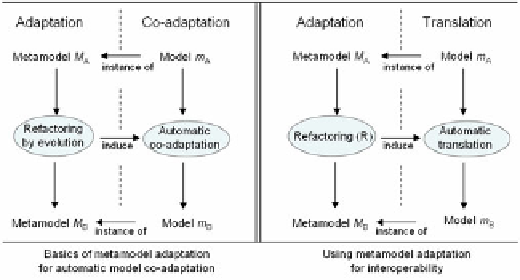Information Technology Reference
In-Depth Information
target model can be viewed as a particular case of applying general rules to transform
the differences between the corresponding metamodels.
3.1 Wachsmuth's Proposal on Metamodel Adaptation
In 2007, Guido Wachsmuth presented a proposal [12] to deal with the problem of
metamodel evolution and its implications for adapting its instance models according
to this evolution (see Fig. 1, left). The basic hypothesis is that co-adaptation of
models can be automatically derived from well-defined metamodel evolution steps.
Wachsmuth defines different semantic-preserving categories and matches them
with specific refactoring operations on metamodels. The way of handling semantic-
preserving features respond to the concept of semantics already introduced, i.e., se-
mantic preservation is not characterized by meaning but by structural changes on
corresponding metamodels.
Here, we are proposing the adoption of this framework in the context of the prob-
lem of translating models among metamodels which have a common set of concepts
(see Fig. 1, right). In other words, we change the perspective:
-
from:
given a model
m
A
created as instance of a metamodel
M
A
, translate it into
another model
m
B
created as instance of a metamodel
M
B
via a metamodel corre-
spondence,
-
into:
given a model
m
A
created as instance of a metamodel
M
A
, and given a
metamodel evolution from
M
A
to
M
B
, co-adapt the model
m
A
into another model
m
B
created as instance of
M
B
via some metamodel refactoring operations.
Fig. 1.
Comparative between co-adaptation and interoperability via metamodel refactoring
3.2 Wachsmuth's Proposal: Relationships and Semantic Preservation
To characterize refactoring operations Wachsmuth proposes some basic concepts:
M
M
represents all the metamodels conforming to a specific metamodel formalism
M, denoted by
M
M
:= {
μ
╞ M}. Although it is not really relevant, we may assume
MOF 2.0 formalism in this paper.
−
−
C
M
(μ)
represents the concepts defined by a particular metamodel
μ
. In our case,
typical concepts would be
actor
,
intentional element
, etc.

